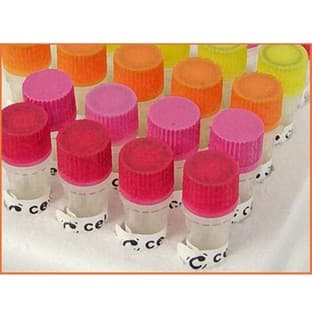
Supplier:
Aviva Systems Biology IncorporatedSEPP1 (selenoprotein P, plasma, 1) Blocking Peptide (the N terminal of protein) (100ug)
Prices direct from Aviva Systems Biology Incorporated
Quick response times
Exclusive Absave savings/discounts
SPECIFICATIONS
Size
100 ug
Format
Lyophilized powder
Presku
AAP56299
Target
SEPP1 is a selenoprotein containing multiple selenocysteine (Sec) residues, which are encoded by the UGA codon that normally signals translation termination. The 3' UTR of selenoprotein genes have a common stem-loop structure, the sec insertion sequence (SECIS), which is necessary for the recognition of UGA as a Sec codon rather than as a stop signal. This selenoprotein is an extracellular glycoprotein, and is unusual in that it contains 10 Sec residues per polypeptide. It is a heparin-binding protein that appears to be associated with endothelial cells, and has been implicated to function as an antioxidant in the extracellular space.This gene encodes a selenoprotein containing multiple selenocysteine (Sec) residues, which are encoded by the UGA codon that normally signals translation termination. The 3' UTR of selenoprotein genes have a common stem-loop structure, the sec insertion sequence (SECIS), which is necessary for the recognition of UGA as a Sec codon rather than as a stop signal. This selenoprotein is an extracellular glycoprotein, and is unusual in that it contains 10 Sec residues per polypeptide. It is a heparin-binding protein that appears to be associated with endothelial cells, and has been implicated to function as an antioxidant in the extracellular space. Several transcript variants, encoding either the same or different isoform, have been found for this gene.
Weight
46kDa
Gene Id
6414
Alternative Names
SELP; SeP
Applications
ELISA, WB
Hosts
Mouse
Applications
IHC
Hosts
Mouse
Latest promotions
Buy any polyclonal or monoclonal antibody from our extensive range of pre-made antibodies and for a limited time only receive a $50 discount!(T&C apply:...
New brilliant antibodies, and new lower prices!For flow cytometry reagents in general, \"bright is better.\" The violet-excitable BD Horizon™ BV421 and...
Did your supplier increase the price of Fetal Bovine Serum? Did they substitute the US Origin with USDA? Well say no more! Innovative Research is still...
10% Discount on 2 Rabbit Polyclonal Antibody Service. With over 20 years experience, SDIX has developed into the premier US custom antibody producer,...
For the past decade scientists have extensively used ATS secondary toxin conjugates to make their own targeted toxins for in vitro use.The ability to combine...
We're so sure that you'll prefer Cayman Assay kits over your present brand that we're willing to give you a free assay kit to prove it!
Bulk Cytokines with Custom Vialing.20 - 50% off cytokines, growth factors, chemokines and more...For a limited time Cell Sciences is offering substantial...
Are you planning to have a customised antibody made for your research?Since 2000, Everest has been producing a catalog containing thousands of affinity...
Top suppliers
Agrisera AB
11 products
Biotrend
Biosensis
969 products
ABBIOTEC
3011 products
SDIX
1 products
Spring Bioscience
2291 products
Cell Signaling Technology
4976 products
Rockland Immunochemicals, Inc.
7592 products
Boster Immunoleader
1533 products
OriGene Technologies Inc.
5281 products
Maine Biotechnology Services
227 products
BD (Becton, Dickinson and Company)
1 products
ABNOVA CORPORATION
Randox Life Sciences
1502 products














